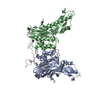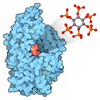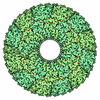+ データを開く
データを開く
- 基本情報
基本情報
| 登録情報 | データベース: PDB / ID: 8bah | |||||||||||||||
|---|---|---|---|---|---|---|---|---|---|---|---|---|---|---|---|---|
| タイトル | Human Mre11-Nbs1 complex | |||||||||||||||
 要素 要素 |
| |||||||||||||||
 キーワード キーワード | HYDROLASE / DNA repair / complex | |||||||||||||||
| 機能・相同性 |  機能・相同性情報 機能・相同性情報telomere maintenance via telomere trimming / chromosomal region / telomeric 3' overhang formation / mitochondrial double-strand break repair via homologous recombination / Mre11 complex / negative regulation of double-strand break repair via nonhomologous end joining / blastocyst growth / negative regulation of telomere capping / BRCA1-C complex / meiotic DNA double-strand break formation ...telomere maintenance via telomere trimming / chromosomal region / telomeric 3' overhang formation / mitochondrial double-strand break repair via homologous recombination / Mre11 complex / negative regulation of double-strand break repair via nonhomologous end joining / blastocyst growth / negative regulation of telomere capping / BRCA1-C complex / meiotic DNA double-strand break formation / Sensing of DNA Double Strand Breaks / regulation of mitotic recombination / protection from non-homologous end joining at telomere / R-loop processing / t-circle formation / single-stranded DNA endodeoxyribonuclease activity / phosphorylation-dependent protein binding / homologous chromosome pairing at meiosis / DNA strand resection involved in replication fork processing / nuclease activity / homologous recombination / nuclear inclusion body / 3'-5'-DNA exonuclease activity / DNA double-strand break processing / Impaired BRCA2 binding to PALB2 / double-strand break repair via alternative nonhomologous end joining / chromatin-protein adaptor activity / protein localization to site of double-strand break / isotype switching / Cytosolic sensors of pathogen-associated DNA / HDR through MMEJ (alt-NHEJ) / mitotic G2/M transition checkpoint / IRF3-mediated induction of type I IFN / reciprocal meiotic recombination / mitotic intra-S DNA damage checkpoint signaling / regulation of DNA-templated DNA replication initiation / sister chromatid cohesion / Homologous DNA Pairing and Strand Exchange / Defective homologous recombination repair (HRR) due to BRCA1 loss of function / Defective HDR through Homologous Recombination Repair (HRR) due to PALB2 loss of BRCA1 binding function / Defective HDR through Homologous Recombination Repair (HRR) due to PALB2 loss of BRCA2/RAD51/RAD51C binding function / Resolution of D-loop Structures through Synthesis-Dependent Strand Annealing (SDSA) / Resolution of D-loop Structures through Holliday Junction Intermediates / HDR through Single Strand Annealing (SSA) / positive regulation of double-strand break repair / Impaired BRCA2 binding to RAD51 / mitotic G2 DNA damage checkpoint signaling / positive regulation of telomere maintenance / telomere maintenance in response to DNA damage / Presynaptic phase of homologous DNA pairing and strand exchange / neuromuscular process controlling balance / protein K63-linked ubiquitination / neuroblast proliferation / telomere maintenance via telomerase / positive regulation of double-strand break repair via homologous recombination / 3'-5' exonuclease activity / telomere maintenance / intrinsic apoptotic signaling pathway / DNA damage checkpoint signaling / protein serine/threonine kinase activator activity / replication fork / DNA endonuclease activity / meiotic cell cycle / DNA damage response, signal transduction by p53 class mediator / Nonhomologous End-Joining (NHEJ) / double-strand break repair via homologous recombination / G2/M DNA damage checkpoint / PML body / DNA Damage/Telomere Stress Induced Senescence / Meiotic recombination / HDR through Homologous Recombination (HRR) / double-strand break repair via nonhomologous end joining / double-strand break repair / Recruitment and ATM-mediated phosphorylation of repair and signaling proteins at DNA double strand breaks / manganese ion binding / site of double-strand break / Processing of DNA double-strand break ends / double-stranded DNA binding / DNA recombination / Regulation of TP53 Activity through Phosphorylation / DNA-binding transcription factor binding / histone binding / damaged DNA binding / 加水分解酵素; エステル加水分解酵素 / chromosome, telomeric region / cell population proliferation / regulation of cell cycle / cadherin binding / DNA repair / DNA damage response / negative regulation of apoptotic process / nucleolus / Golgi apparatus / nucleoplasm / identical protein binding / nucleus / cytosol / cytoplasm 類似検索 - 分子機能 | |||||||||||||||
| 生物種 |  Homo sapiens (ヒト) Homo sapiens (ヒト) | |||||||||||||||
| 手法 | 電子顕微鏡法 / 単粒子再構成法 / クライオ電子顕微鏡法 / 解像度: 4.13 Å | |||||||||||||||
 データ登録者 データ登録者 | Bartho, J.D. / Rotheneder, M. / Stakyte, K. / Lammens, K. / Hopfner, K.P. | |||||||||||||||
| 資金援助 |  ドイツ, 4件 ドイツ, 4件
| |||||||||||||||
 引用 引用 |  ジャーナル: Mol Cell / 年: 2023 ジャーナル: Mol Cell / 年: 2023タイトル: Cryo-EM structure of the Mre11-Rad50-Nbs1 complex reveals the molecular mechanism of scaffolding functions. 著者: Matthias Rotheneder / Kristina Stakyte / Erik van de Logt / Joseph D Bartho / Katja Lammens / Yilan Fan / Aaron Alt / Brigitte Kessler / Christophe Jung / Wynand P Roos / Barbara ...著者: Matthias Rotheneder / Kristina Stakyte / Erik van de Logt / Joseph D Bartho / Katja Lammens / Yilan Fan / Aaron Alt / Brigitte Kessler / Christophe Jung / Wynand P Roos / Barbara Steigenberger / Karl-Peter Hopfner /  要旨: The DNA double-strand break repair complex Mre11-Rad50-Nbs1 (MRN) detects and nucleolytically processes DNA ends, activates the ATM kinase, and tethers DNA at break sites. How MRN can act both as ...The DNA double-strand break repair complex Mre11-Rad50-Nbs1 (MRN) detects and nucleolytically processes DNA ends, activates the ATM kinase, and tethers DNA at break sites. How MRN can act both as nuclease and scaffold protein is not well understood. The cryo-EM structure of MRN from Chaetomium thermophilum reveals a 2:2:1 complex with a single Nbs1 wrapping around the autoinhibited Mre11 nuclease dimer. MRN has two DNA-binding modes, one ATP-dependent mode for loading onto DNA ends and one ATP-independent mode through Mre11's C terminus, suggesting how it may interact with DSBs and intact DNA. MRNs two 60-nm-long coiled-coil domains form a linear rod structure, the apex of which is assembled by the two joined zinc-hook motifs. Apices from two MRN complexes can further dimerize, forming 120-nm spanning MRN-MRN structures. Our results illustrate the architecture of MRN and suggest how it mechanistically integrates catalytic and tethering functions. | |||||||||||||||
| 履歴 |
|
- 構造の表示
構造の表示
| 構造ビューア | 分子:  Molmil Molmil Jmol/JSmol Jmol/JSmol |
|---|
- ダウンロードとリンク
ダウンロードとリンク
- ダウンロード
ダウンロード
| PDBx/mmCIF形式 |  8bah.cif.gz 8bah.cif.gz | 316.3 KB | 表示 |  PDBx/mmCIF形式 PDBx/mmCIF形式 |
|---|---|---|---|---|
| PDB形式 |  pdb8bah.ent.gz pdb8bah.ent.gz | 244 KB | 表示 |  PDB形式 PDB形式 |
| PDBx/mmJSON形式 |  8bah.json.gz 8bah.json.gz | ツリー表示 |  PDBx/mmJSON形式 PDBx/mmJSON形式 | |
| その他 |  その他のダウンロード その他のダウンロード |
-検証レポート
| 文書・要旨 |  8bah_validation.pdf.gz 8bah_validation.pdf.gz | 1.1 MB | 表示 |  wwPDB検証レポート wwPDB検証レポート |
|---|---|---|---|---|
| 文書・詳細版 |  8bah_full_validation.pdf.gz 8bah_full_validation.pdf.gz | 1.1 MB | 表示 | |
| XML形式データ |  8bah_validation.xml.gz 8bah_validation.xml.gz | 34.4 KB | 表示 | |
| CIF形式データ |  8bah_validation.cif.gz 8bah_validation.cif.gz | 50.3 KB | 表示 | |
| アーカイブディレクトリ |  https://data.pdbj.org/pub/pdb/validation_reports/ba/8bah https://data.pdbj.org/pub/pdb/validation_reports/ba/8bah ftp://data.pdbj.org/pub/pdb/validation_reports/ba/8bah ftp://data.pdbj.org/pub/pdb/validation_reports/ba/8bah | HTTPS FTP |
-関連構造データ
| 関連構造データ |  15948MC  7zqyC  7zr1C M: このデータのモデリングに利用したマップデータ C: 同じ文献を引用 ( |
|---|---|
| 類似構造データ | 類似検索 - 機能・相同性  F&H 検索 F&H 検索 |
- リンク
リンク
- 集合体
集合体
| 登録構造単位 | 
|
|---|---|
| 1 |
|
- 要素
要素
| #1: タンパク質 | 分子量: 84008.633 Da / 分子数: 2 / 変異: H129N / 由来タイプ: 組換発現 / 由来: (組換発現)  Homo sapiens (ヒト) / 遺伝子: MRE11, HNGS1, MRE11A / プラスミド: pACEMam1_pMDC / 細胞株 (発現宿主): HEK293T / 発現宿主: Homo sapiens (ヒト) / 遺伝子: MRE11, HNGS1, MRE11A / プラスミド: pACEMam1_pMDC / 細胞株 (発現宿主): HEK293T / 発現宿主:  Homo sapiens (ヒト) Homo sapiens (ヒト)参照: UniProt: P49959, 加水分解酵素; エステル加水分解酵素 #2: タンパク質 | | 分子量: 85073.023 Da / 分子数: 1 / 由来タイプ: 組換発現 / 由来: (組換発現)  Homo sapiens (ヒト) / 遺伝子: NBN, NBS, NBS1, P95 / プラスミド: pACEMam1_pMDC / 細胞株 (発現宿主): HEK293T / 発現宿主: Homo sapiens (ヒト) / 遺伝子: NBN, NBS, NBS1, P95 / プラスミド: pACEMam1_pMDC / 細胞株 (発現宿主): HEK293T / 発現宿主:  Homo sapiens (ヒト) / 参照: UniProt: O60934 Homo sapiens (ヒト) / 参照: UniProt: O60934#3: 化合物 | ChemComp-MN / 研究の焦点であるリガンドがあるか | Y | |
|---|
-実験情報
-実験
| 実験 | 手法: 電子顕微鏡法 |
|---|---|
| EM実験 | 試料の集合状態: PARTICLE / 3次元再構成法: 単粒子再構成法 |
- 試料調製
試料調製
| 構成要素 | 名称: Human Mre11-Nbs1 complex / タイプ: COMPLEX / 詳細: Human Mre11-dimer with Nbs1 C-terminal chain bound. / Entity ID: #1-#2 / 由来: RECOMBINANT | |||||||||||||||||||||||||||||||||||||||||||||
|---|---|---|---|---|---|---|---|---|---|---|---|---|---|---|---|---|---|---|---|---|---|---|---|---|---|---|---|---|---|---|---|---|---|---|---|---|---|---|---|---|---|---|---|---|---|---|
| 分子量 | 実験値: NO | |||||||||||||||||||||||||||||||||||||||||||||
| 由来(天然) | 生物種:  Homo sapiens (ヒト) Homo sapiens (ヒト) | |||||||||||||||||||||||||||||||||||||||||||||
| 由来(組換発現) | 生物種:  Homo sapiens (ヒト) / 細胞: HEK293T / プラスミド: pACEMam1_pMDC Homo sapiens (ヒト) / 細胞: HEK293T / プラスミド: pACEMam1_pMDC | |||||||||||||||||||||||||||||||||||||||||||||
| 緩衝液 | pH: 7 詳細: 20 mM HEPES (pH 7.0), 140 mM NaCl, 5 mM MgCl2, 1 mM MnCl2, 0.020 mM ZnCl2, 0.2 mM TCEP, 2 mM ATPgS, plus 0.05 percent beta-OG | |||||||||||||||||||||||||||||||||||||||||||||
| 緩衝液成分 |
| |||||||||||||||||||||||||||||||||||||||||||||
| 試料 | 濃度: 0.29 mg/ml / 包埋: NO / シャドウイング: NO / 染色: NO / 凍結: YES | |||||||||||||||||||||||||||||||||||||||||||||
| 試料支持 | グリッドの材料: COPPER / グリッドのサイズ: 200 divisions/in. / グリッドのタイプ: Quantifoil R2/1 | |||||||||||||||||||||||||||||||||||||||||||||
| 急速凍結 | 装置: LEICA EM GP / 凍結剤: ETHANE / 湿度: 95 % / 凍結前の試料温度: 288 K |
- 電子顕微鏡撮影
電子顕微鏡撮影
| 実験機器 |  モデル: Titan Krios / 画像提供: FEI Company |
|---|---|
| 顕微鏡 | モデル: FEI TITAN KRIOS |
| 電子銃 | 電子線源:  FIELD EMISSION GUN / 加速電圧: 300 kV / 照射モード: FLOOD BEAM FIELD EMISSION GUN / 加速電圧: 300 kV / 照射モード: FLOOD BEAM |
| 電子レンズ | モード: BRIGHT FIELD / 倍率(公称値): 13000 X / 最大 デフォーカス(公称値): 2800 nm / 最小 デフォーカス(公称値): 1000 nm / Cs: 2.7 mm / C2レンズ絞り径: 50 µm |
| 試料ホルダ | 凍結剤: NITROGEN 試料ホルダーモデル: FEI TITAN KRIOS AUTOGRID HOLDER |
| 撮影 | 平均露光時間: 10 sec. / 電子線照射量: 43 e/Å2 / 検出モード: COUNTING フィルム・検出器のモデル: GATAN K2 SUMMIT (4k x 4k) 撮影したグリッド数: 3 / 実像数: 11325 |
| 電子光学装置 | エネルギーフィルター名称: GIF Bioquantum / エネルギーフィルタースリット幅: 20 eV |
| 画像スキャン | 動画フレーム数/画像: 40 |
- 解析
解析
| ソフトウェア | 名称: PHENIX / バージョン: 1.20.1_4487: / 分類: 精密化 | ||||||||||||||||||||||||||||||||||||
|---|---|---|---|---|---|---|---|---|---|---|---|---|---|---|---|---|---|---|---|---|---|---|---|---|---|---|---|---|---|---|---|---|---|---|---|---|---|
| EMソフトウェア |
| ||||||||||||||||||||||||||||||||||||
| CTF補正 | タイプ: PHASE FLIPPING AND AMPLITUDE CORRECTION | ||||||||||||||||||||||||||||||||||||
| 3次元再構成 | 解像度: 4.13 Å / 解像度の算出法: FSC 0.143 CUT-OFF / 粒子像の数: 282838 / 対称性のタイプ: POINT | ||||||||||||||||||||||||||||||||||||
| 拘束条件 |
|
 ムービー
ムービー コントローラー
コントローラー









 PDBj
PDBj










